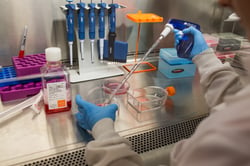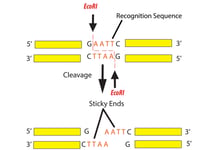 This post was contributed by guest blogger Sean D. Stacey. Opinions on the apps discussed in the article are those of the guest blogger and do not necessarily represent the views of Addgene.
This post was contributed by guest blogger Sean D. Stacey. Opinions on the apps discussed in the article are those of the guest blogger and do not necessarily represent the views of Addgene.
I think it’s safe to assume that anyone reading this article has a smartphone nearby. We tailor these devices to our own interests with the content we store in them: music, emails, chats, pictures, and apps. Throughout my time as a graduate student, I have relied more and more heavily on adapting my smartphone to help me with my research in terms of preparedness, organization, and sharing data. Here are five FREE science lab apps that have been educational and great for lab life. These apps prevent you from constantly searching the interwebs for lab resources, and instead conveniently provide them on your smart phone.
1. Lab Archives by LabArchives
 The single, most important part of lab life is the lab notebook. Lab Archives is a multipurpose application that allows you to share your data with colleagues and link your notebook from your smartphone to your computer. Lab Archives will help both you and your lab stay organized allowing you to upload anything from protocols to pictures of gels or even sketches to your notebook. The files uploaded are saved and cannot be deleted, so there is no worry about misplacing your results or losing that lab notebook from 2 years ago. The free subscription to Lab Archives allots for 25 MB of space per user, but, if you need more space, you can sign up for a plan. Best of all, by not using paper lab notebooks you’re saving trees! The Earth thanks you.
The single, most important part of lab life is the lab notebook. Lab Archives is a multipurpose application that allows you to share your data with colleagues and link your notebook from your smartphone to your computer. Lab Archives will help both you and your lab stay organized allowing you to upload anything from protocols to pictures of gels or even sketches to your notebook. The files uploaded are saved and cannot be deleted, so there is no worry about misplacing your results or losing that lab notebook from 2 years ago. The free subscription to Lab Archives allots for 25 MB of space per user, but, if you need more space, you can sign up for a plan. Best of all, by not using paper lab notebooks you’re saving trees! The Earth thanks you.
2. Gibco Cell Culture by Gibco
 Whenever I start to learn a new technique, I try to look for a resource to help me. I’m still waiting for a mass spectrometry app. I digress. When I started learning proper cell culture technique, I tried to find an app that could help me with calculations. This is how I came across the Gibco Cell Culture app. Gibco organizes its app into four categories: tools, analytics, education and data manager. The tools are a lifesaver when your research requires cell culture and include a counter, lab timer, dilution calculator, and a couple of other nice features. This app also has a great educational section. This section holds the Gibco Cell culture manual and basic instructional videos. The search function in the manual just highlights what the user searches, which is not very helpful, but does make it easy to skim the manual. Overall, it’s a great tool for someone starting cell culture work.
Whenever I start to learn a new technique, I try to look for a resource to help me. I’m still waiting for a mass spectrometry app. I digress. When I started learning proper cell culture technique, I tried to find an app that could help me with calculations. This is how I came across the Gibco Cell Culture app. Gibco organizes its app into four categories: tools, analytics, education and data manager. The tools are a lifesaver when your research requires cell culture and include a counter, lab timer, dilution calculator, and a couple of other nice features. This app also has a great educational section. This section holds the Gibco Cell culture manual and basic instructional videos. The search function in the manual just highlights what the user searches, which is not very helpful, but does make it easy to skim the manual. Overall, it’s a great tool for someone starting cell culture work.
3. NEB Tools by New England BioLabs
 In my lab we do a lot of genetic construction and cloning experiments. Not all of our lab enzymes are made by New England BioLabs, but the NEB Tools app comes in handy when I use protocols that require restriction enzymes or PCR. The app contains a double digest tool that is only helpful for NEB restriction enzymes since the instructions use NEB buffers. Nonetheless, if you are setting up a double digest with NEB enzymes, the app is quite helpful and provides a list of directions including which buffers to use and that indicates if a sequential digest is needed. The enzyme finder is also a very helpful aspect to this app; the user can search by sequence, category of enzyme, or name to discover all the information about that restriction enzyme or share it via email with a colleague. The app is also great if you’re adding a restriction site to a primer, you only need to skim the alphabet on the side of the screen to find the sequence for your enzyme of interest. Lastly, the Tm calculator helps you set up an optimal PCR depending on the primer sequence and the NEB polymerase used. Overall, while much of the information in the app is restricted to the NEB inventory only, the restriction enzyme sequence resource is universally useful.
In my lab we do a lot of genetic construction and cloning experiments. Not all of our lab enzymes are made by New England BioLabs, but the NEB Tools app comes in handy when I use protocols that require restriction enzymes or PCR. The app contains a double digest tool that is only helpful for NEB restriction enzymes since the instructions use NEB buffers. Nonetheless, if you are setting up a double digest with NEB enzymes, the app is quite helpful and provides a list of directions including which buffers to use and that indicates if a sequential digest is needed. The enzyme finder is also a very helpful aspect to this app; the user can search by sequence, category of enzyme, or name to discover all the information about that restriction enzyme or share it via email with a colleague. The app is also great if you’re adding a restriction site to a primer, you only need to skim the alphabet on the side of the screen to find the sequence for your enzyme of interest. Lastly, the Tm calculator helps you set up an optimal PCR depending on the primer sequence and the NEB polymerase used. Overall, while much of the information in the app is restricted to the NEB inventory only, the restriction enzyme sequence resource is universally useful.
4. Chemical Safety Data Sheets by ThatsMyStapler
 Safety always comes first with research! It is always important to know what kind of reagents you work with in experiments. Hence, I’m including this MSDS app. The Chemical Safety Data Sheets app has a search function that allows the user to find an MSDS for a lab chemical of choice. Now, I can’t guarantee every reagent in your chemical closet is in this app. However, if you get quizzed randomly about a hazardous chemical and can’t find your lab’s MSDS book, this is a great resource to have in your pocket.
Safety always comes first with research! It is always important to know what kind of reagents you work with in experiments. Hence, I’m including this MSDS app. The Chemical Safety Data Sheets app has a search function that allows the user to find an MSDS for a lab chemical of choice. Now, I can’t guarantee every reagent in your chemical closet is in this app. However, if you get quizzed randomly about a hazardous chemical and can’t find your lab’s MSDS book, this is a great resource to have in your pocket.
5. +AMINO- by iGreenEarth
 AMINO is a very simple app that packs important biological information, amino acid abbreviations, and structures into one convenient resource. I can safely say that I still have the single and triple abbreviations of the amino acids memorized, but the structures are another story. AMINO has been very helpful when I’ve had to explain the properties of or draw an amino acid or peptide for some reason. It contains all twenty amino acids plus selenocysteine and pyrrolysine. I have found myself wishing that it had a codon list for each amino acid, but, overall AMINO can be beneficial for new researchers or students beginning to learn about biochemistry. The least this app will do is allow you to write your colleagues’ names in a polypeptide chain, except if their names have a B, J, X, or Z.
AMINO is a very simple app that packs important biological information, amino acid abbreviations, and structures into one convenient resource. I can safely say that I still have the single and triple abbreviations of the amino acids memorized, but the structures are another story. AMINO has been very helpful when I’ve had to explain the properties of or draw an amino acid or peptide for some reason. It contains all twenty amino acids plus selenocysteine and pyrrolysine. I have found myself wishing that it had a codon list for each amino acid, but, overall AMINO can be beneficial for new researchers or students beginning to learn about biochemistry. The least this app will do is allow you to write your colleagues’ names in a polypeptide chain, except if their names have a B, J, X, or Z.
Some alternative, similar apps:
- Findings Lab Notebook
- Cell Culture Split Calculator by DRDP
- Restriction Enzyme Tool by Promega
- Material Safety Data Sheet by RSS-ICTD
- Amino Acid Structure Quiz/Card by Andrey Solovyev
- Lab Help by Kris Shamloo
These are just a few of the many apps available to help researchers in the lab. If you have a favorite lab app, please share it in the comments section below!
Many thanks to our guest blogger Sean Stacey!
 Sean D. Stacey is a Ph.D. student at East Tennessee State University. He works with gene expression in Pseudomonas aeruginosa. Follow him on twitter @100percentSDS.
Sean D. Stacey is a Ph.D. student at East Tennessee State University. He works with gene expression in Pseudomonas aeruginosa. Follow him on twitter @100percentSDS.
Additional Resources on the Addgene Blog
- Learn How to Keep a Lab Notebook for Bioinformatic Analyses
- Use Apps to Share Your Lab Protocols
- Check Out How Addgene Develops Lab Management Software
Resources on Addgene.org
- Find Protoctols for Your Research
- Catch Up On Your Molecular Biology Basics
Topics: Other, Miscellaneous





Leave a Comment